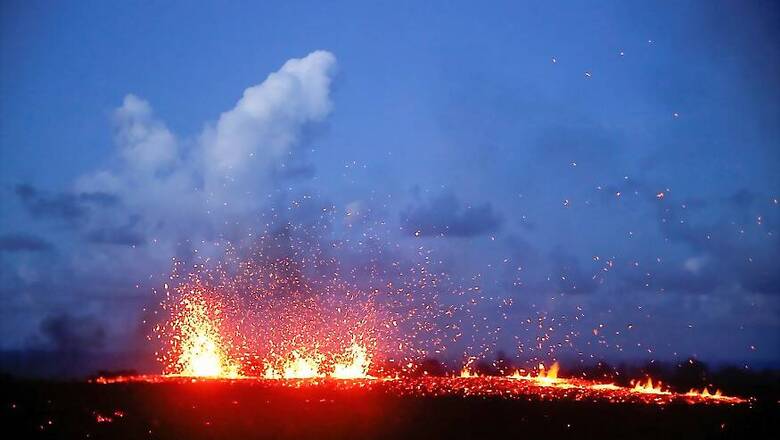
views
Pahoa, Hawaii: Explosions intensified on Hawaii's Kilauea volcano on Tuesday, spewing ash and sparking a red alert for aviation for the first time since the latest eruption began 12 days ago.
Ash and volcanic smog, or so-called vog, rose up to 12,000 feet (3,657 meters) above Kilauea's crater and floated southwest, covering cars on Highway 11 with gray dust and sparking an "unhealthy air" advisory in the community of Pahala, 18 miles (29 km) from the summit.
An aviation red alert means a volcanic eruption is under way that could affect aviation by spewing ash into air routes, according to the U.S. Geological Survey (USGS) website.
Ash was also a new hazard for residents of Hawaii's Big Island already dealing with volcanic gas and lava that has destroyed 37 homes and other structures and forced around 2,000 residents to evacuate.
A shift in winds was expected to bring ash and vog inland on Wednesday and make them more concentrated, said John Bravender of the National Oceanic and Atmospheric Administration (NOAA).
"We're observing more or less continuous emission of ash now with intermittent, more energetic ash bursts or plumes," said Hawaiian Volcano Observatory (HVO) Deputy Scientist-In-Charge Steve Brantley on a conference call with reporters.
The observatory warned the eruption could become more violent.
"At any time, activity may become more explosive, increasing the intensity of ash production and producing ballistic projectiles near the vent," the HVO said in a statement on the change in aviation alert level to red from orange.
Ash is not poisonous but causes irritation to the nose, eyes and airways. It can make roads slippery and if emitted in large quantities could cause electrical power lines to fail, said USGS chemist David Damby.
NEW FISSURE
The eruption has taken its toll on the island's tourism industry.
Big Island hotel bookings for summer months are off almost 50 percent from last year, Rob Birch, executive director of the Island of Hawaii Visitor Bureau, told journalists on a conference call.
The area bearing the brunt of the eruption lies about 25 miles (40 km) down Kilauea's eastern flank, near the village of Pahoa. Lava has burst from the ground and torn through housing developments and farmland, threatening one of the last exit routes from coastal areas, state Highway 132.
The latest tear in the earth or fissure opened on Tuesday, spewing lava and toxic gases that made air quality "condition red" around Lanipuna Gardens and nearby farms, causing "choking and inability to breathe," the Hawaiian Volcano Observatory and Hawaii County Civil Defense said.
Road crews put metal plates over steaming cracks on nearby Highway 130 and reopened it to provide coastal residents an escape route in case a lava flow reaches the ocean and blocks another exit artery, Highway 137, Civil Defense said.
There have been no major injuries or death reported from the eruption.
A looming menace remains the possibility of an "explosive eruption" of Kilauea, an event last seen in 1924. Pent-up steam could cause such a blast that would launch a 20,000-foot (6,100-meter) ash plume from the crater and spread debris over 12 miles (19 km), according to the USGS.
There was no evidence of that on Tuesday, but scientists warned it could happen any time.


















Comments
0 comment